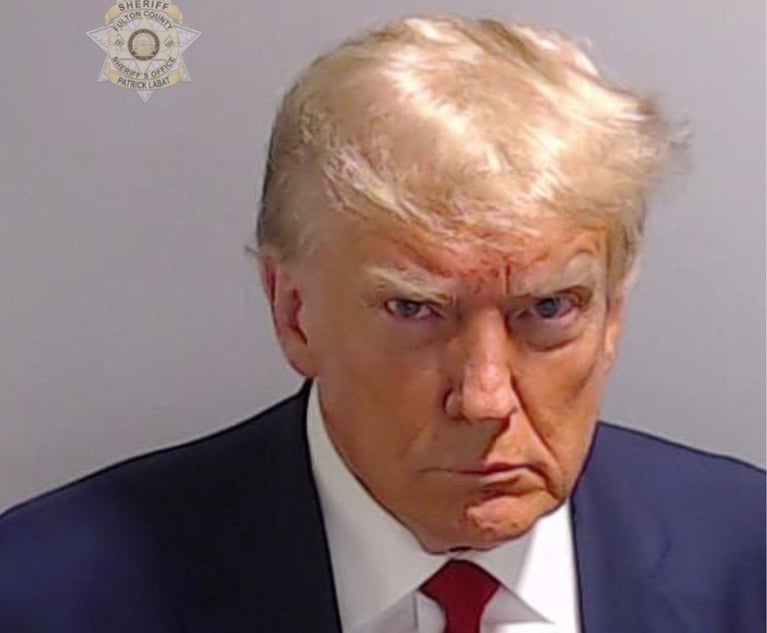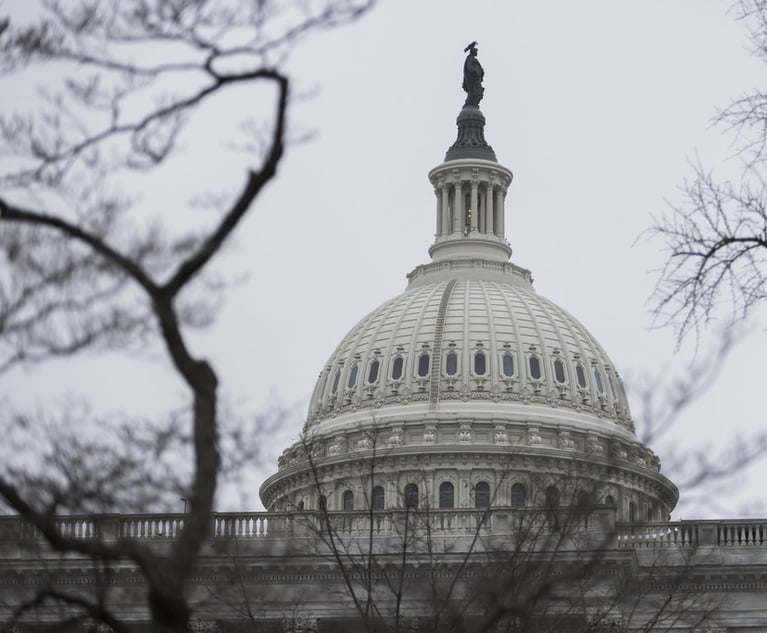'Separation of Powers' Implies Cooperation
Abandonment of the political wisdom underlying the separation of powers should give us pause.
December 01, 2017 at 03:05 PM
13 minute read

The Constitution of Connecticut, article second, as amended by article eighteen of the amendments, provides in relevant part: “The powers of government shall be divided into three distinct departments, and each of them confided to a separate magistracy, to wit, those which are legislative, to one; those which are executive, to another; and those which are judicial, to another.”
The primary purpose of this constitutional doctrine, which is to prevent commingling of different powers of government in the same hands, achieves this purpose by prescribing limitations and duties for each branch that are essential to each branch's independence and performance of assigned powers. “It is axiomatic that no branch of government organized under a constitution may exercise any power that is not explicitly bestowed by that constitution or that is not essential to the exercise thereof” (Kinsella v. Jaekle, 192 Conn. 704, 723 (1984)). The doctrine serves a dual function of limiting the exercise of power within each branch, but also ensuring the independent exercise of that power.
Although the doctrine on its face appears rigid, its application is not. Out of necessity, executive, legislative and judicial powers overlap each other, and they cover many acts that are in their nature common to more than one branch. Courts analyzing whether there has been a violation of the clause examine the degree to which the exercise of various powers “comport with, or threaten to undermine, either the independence and integrity of one of the branches … or the ability of each to fulfill its mission in checking the others so as to preserve the interdependence without which independence can become domination” (L. Tribe, “American Constitutional Law” (2d Ed.1988) §2-2, p. 18). Two questions are asked: whether the actions constitute: (1) an assumption of power that lies exclusively under the control of another branch; or (2) a significant interference with the orderly conduct of the essential functions of another branch (Bartholomew v. Schweizer, 217 Conn. 671, 676 (1991)).
The doctrine is not routinely invoked, and we acknowledge that despite repeated allusions to the existence of the power of judicial review of legislative actions, that power has been exercised only rarely. In fact, as Justice Peters remarked: “separation of powers is largely irrelevant to much of the work of trial court judges and administrators. The governing principle is not separation but networking”. Peters, Ellen Ash, “Getting Away from the Federal Paradigm: Separation of Powers in State Courts” (1997).
Judicial branch staff generally work closely with the Legislature to minimize the risk of future conflicts. With advance notice of pending legislation, the judiciary is able to seize the opportunity to exercise its rule-making authority and amend judicial rules to conform to forthcoming legislative policy initiatives, thereby avoiding a crisis. Of course, whether this indirect involvement of drafting by the judiciary undermines the branch's ability to retain its independence to resolve constitutional challenges to the validity of such legislation is a question in and of itself that has received little or no attention.
What also doesn't get much attention is the following paradigm: the Legislature has the power to designate what is a crime and the sentences for those crimes; the judiciary is given jurisdiction over sentencing within those perimeters; and when the defendant is given a period of incarceration and the sentence has become final, the defendant is transferred to the custody of the Department of Corrections, the executive branch, for execution of the sentence. These same general principles have existed in the juvenile justice world. Youth who are adjudicated delinquent and are in need of more than mere probation, are committed to the Department of Children and Families, which is charged with determining the appropriate placement and treatment.
Nevertheless, just weeks ago, after months of torture, the Legislature passed a budget (June Special Session P.A. 17-2) and included a provision buried deep within, §321, which provides: “(NEW) (Effective from passage) Notwithstanding any provision of the general statutes, on and after July 1, 2018, no child, as defined in section 46b-120 of the general statutes, who has been convicted as delinquent, as described in section 46b-120 of the general statutes, may be committed to the Department of Children and Families as a result of such conviction. The court may sentence any such child to a period of probation that may include, in addition to other orders and conditions set forth in subsections (b) to (e), inclusive, of section 46b-140 of the general statutes, a period of placement in a secure, limited secure or nonsecure residential facility.”
This transfer of the care and custody of youth who have been adjudicated (convicted) delinquent and committed (sentenced) to the Department of Children and Families for the department to determine appropriate placement, including at the Connecticut Juvenile Training School, was done without any discussion of the separation-of-powers doctrine. Without ascribing motives for the transfer or questioning the lack of any public objection by the judicial branch, suffice it to say that such a significant transfer of responsibility deserved, at the very least, some recognition of the essential roles of the three branches of government and the constitutional principle of separation of powers. It's hard to consider the principle of judicial deference to legislative resolution of conflicting considerations of public policy when substantive statutes are enacted as part of a 900-plus-page budget without any discussion of the logic and goals behind them.
We recognize that there are other instances in which roles get blurred. Judicial staff often advise victims of their rights and have even provided funds to offset their losses. Judicial administrators perform work that more closely resembles the work of an executive branch agency than traditional judicial branch responsibilities, filling roles that historically would have been performed by the executive branch of government.
These roles may have come to the judiciary more by way of default than by design, but this transfer of jurisdiction and authority was carefully calculated without any discussion about roles and powers. This is far more than the mere functional blurring of lines of executive, legislative, and judicial power as referenced above. Separation of powers is rooted in very important democratic values. Is this transfer an assumption of power that lies exclusively under the control of another branch; or a significant interference with the orderly conduct of the essential functions of another branch? The absence of any due diligence on this issue is beyond irresponsible.
Abandonment of the political wisdom underlying the separation of powers should give us pause. The absence of meaningful limitations on the power of any one branch of government, even if only as to the few hundred youth who are adjudicated delinquent in a given year may prove to be indigestible in the long run.
What happens to a youth who seeks to bring an action for behavior that takes place in one of the secure facilities where the court was authorized to place him and which the court oversees? Does he raise his claim to his custodian (the Judicial Branch) for adjudication when it was his custodian that placed him in the facility in the first instance? This and many other questions should have been raised, acknowledged, and debated, if not resolved. Advocates and members of all three branches of government are now scrambling to address the how. A fraction of this time should have been spent on the whether.

The Constitution of Connecticut, article second, as amended by article eighteen of the amendments, provides in relevant part: “The powers of government shall be divided into three distinct departments, and each of them confided to a separate magistracy, to wit, those which are legislative, to one; those which are executive, to another; and those which are judicial, to another.”
The primary purpose of this constitutional doctrine, which is to prevent commingling of different powers of government in the same hands, achieves this purpose by prescribing limitations and duties for each branch that are essential to each branch's independence and performance of assigned powers. “It is axiomatic that no branch of government organized under a constitution may exercise any power that is not explicitly bestowed by that constitution or that is not essential to the exercise thereof” (
Although the doctrine on its face appears rigid, its application is not. Out of necessity, executive, legislative and judicial powers overlap each other, and they cover many acts that are in their nature common to more than one branch. Courts analyzing whether there has been a violation of the clause examine the degree to which the exercise of various powers “comport with, or threaten to undermine, either the independence and integrity of one of the branches … or the ability of each to fulfill its mission in checking the others so as to preserve the interdependence without which independence can become domination” (L. Tribe, “American Constitutional Law” (2d Ed.1988) §2-2, p. 18). Two questions are asked: whether the actions constitute: (1) an assumption of power that lies exclusively under the control of another branch; or (2) a significant interference with the orderly conduct of the essential functions of another branch (
The doctrine is not routinely invoked, and we acknowledge that despite repeated allusions to the existence of the power of judicial review of legislative actions, that power has been exercised only rarely. In fact, as Justice Peters remarked: “separation of powers is largely irrelevant to much of the work of trial court judges and administrators. The governing principle is not separation but networking”. Peters, Ellen Ash, “Getting Away from the Federal Paradigm: Separation of Powers in State Courts” (1997).
Judicial branch staff generally work closely with the Legislature to minimize the risk of future conflicts. With advance notice of pending legislation, the judiciary is able to seize the opportunity to exercise its rule-making authority and amend judicial rules to conform to forthcoming legislative policy initiatives, thereby avoiding a crisis. Of course, whether this indirect involvement of drafting by the judiciary undermines the branch's ability to retain its independence to resolve constitutional challenges to the validity of such legislation is a question in and of itself that has received little or no attention.
What also doesn't get much attention is the following paradigm: the Legislature has the power to designate what is a crime and the sentences for those crimes; the judiciary is given jurisdiction over sentencing within those perimeters; and when the defendant is given a period of incarceration and the sentence has become final, the defendant is transferred to the custody of the Department of Corrections, the executive branch, for execution of the sentence. These same general principles have existed in the juvenile justice world. Youth who are adjudicated delinquent and are in need of more than mere probation, are committed to the Department of Children and Families, which is charged with determining the appropriate placement and treatment.
Nevertheless, just weeks ago, after months of torture, the Legislature passed a budget (June Special Session P.A. 17-2) and included a provision buried deep within, §321, which provides: “(NEW) (Effective from passage) Notwithstanding any provision of the general statutes, on and after July 1, 2018, no child, as defined in section 46b-120 of the general statutes, who has been convicted as delinquent, as described in section 46b-120 of the general statutes, may be committed to the Department of Children and Families as a result of such conviction. The court may sentence any such child to a period of probation that may include, in addition to other orders and conditions set forth in subsections (b) to (e), inclusive, of section 46b-140 of the general statutes, a period of placement in a secure, limited secure or nonsecure residential facility.”
This transfer of the care and custody of youth who have been adjudicated (convicted) delinquent and committed (sentenced) to the Department of Children and Families for the department to determine appropriate placement, including at the Connecticut Juvenile Training School, was done without any discussion of the separation-of-powers doctrine. Without ascribing motives for the transfer or questioning the lack of any public objection by the judicial branch, suffice it to say that such a significant transfer of responsibility deserved, at the very least, some recognition of the essential roles of the three branches of government and the constitutional principle of separation of powers. It's hard to consider the principle of judicial deference to legislative resolution of conflicting considerations of public policy when substantive statutes are enacted as part of a 900-plus-page budget without any discussion of the logic and goals behind them.
We recognize that there are other instances in which roles get blurred. Judicial staff often advise victims of their rights and have even provided funds to offset their losses. Judicial administrators perform work that more closely resembles the work of an executive branch agency than traditional judicial branch responsibilities, filling roles that historically would have been performed by the executive branch of government.
These roles may have come to the judiciary more by way of default than by design, but this transfer of jurisdiction and authority was carefully calculated without any discussion about roles and powers. This is far more than the mere functional blurring of lines of executive, legislative, and judicial power as referenced above. Separation of powers is rooted in very important democratic values. Is this transfer an assumption of power that lies exclusively under the control of another branch; or a significant interference with the orderly conduct of the essential functions of another branch? The absence of any due diligence on this issue is beyond irresponsible.
Abandonment of the political wisdom underlying the separation of powers should give us pause. The absence of meaningful limitations on the power of any one branch of government, even if only as to the few hundred youth who are adjudicated delinquent in a given year may prove to be indigestible in the long run.
What happens to a youth who seeks to bring an action for behavior that takes place in one of the secure facilities where the court was authorized to place him and which the court oversees? Does he raise his claim to his custodian (the Judicial Branch) for adjudication when it was his custodian that placed him in the facility in the first instance? This and many other questions should have been raised, acknowledged, and debated, if not resolved. Advocates and members of all three branches of government are now scrambling to address the how. A fraction of this time should have been spent on the whether.
This content has been archived. It is available through our partners, LexisNexis® and Bloomberg Law.
To view this content, please continue to their sites.
Not a Lexis Subscriber?
Subscribe Now
Not a Bloomberg Law Subscriber?
Subscribe Now
NOT FOR REPRINT
© 2025 ALM Global, LLC, All Rights Reserved. Request academic re-use from www.copyright.com. All other uses, submit a request to [email protected]. For more information visit Asset & Logo Licensing.
You Might Like
View All


Elected but Convicted: Attempts to Delay President-Elect's Sentencing Were Unfounded and Exhausted
4 minute read
Trending Stories
- 1John Deere Annual Meeting Offers Peek Into DEI Strife That Looms for Companies Nationwide
- 2Why Associates in This Growing Legal Market Are Leaving Their Firms
- 3Visa's Defense of DOJ Antitrust Case Suffers Setback After Court Denies Motion to Dismiss
- 4Greenberg Traurig Combines Digital Infrastructure and Real Estate Groups, Anticipating Uptick in Demand
- 5Trump Administration Faces Legal Challenge Over EO Impacting Federal Workers
Who Got The Work
J. Brugh Lower of Gibbons has entered an appearance for industrial equipment supplier Devco Corporation in a pending trademark infringement lawsuit. The suit, accusing the defendant of selling knock-off Graco products, was filed Dec. 18 in New Jersey District Court by Rivkin Radler on behalf of Graco Inc. and Graco Minnesota. The case, assigned to U.S. District Judge Zahid N. Quraishi, is 3:24-cv-11294, Graco Inc. et al v. Devco Corporation.
Who Got The Work
Rebecca Maller-Stein and Kent A. Yalowitz of Arnold & Porter Kaye Scholer have entered their appearances for Hanaco Venture Capital and its executives, Lior Prosor and David Frankel, in a pending securities lawsuit. The action, filed on Dec. 24 in New York Southern District Court by Zell, Aron & Co. on behalf of Goldeneye Advisors, accuses the defendants of negligently and fraudulently managing the plaintiff's $1 million investment. The case, assigned to U.S. District Judge Vernon S. Broderick, is 1:24-cv-09918, Goldeneye Advisors, LLC v. Hanaco Venture Capital, Ltd. et al.
Who Got The Work
Attorneys from A&O Shearman has stepped in as defense counsel for Toronto-Dominion Bank and other defendants in a pending securities class action. The suit, filed Dec. 11 in New York Southern District Court by Bleichmar Fonti & Auld, accuses the defendants of concealing the bank's 'pervasive' deficiencies in regards to its compliance with the Bank Secrecy Act and the quality of its anti-money laundering controls. The case, assigned to U.S. District Judge Arun Subramanian, is 1:24-cv-09445, Gonzalez v. The Toronto-Dominion Bank et al.
Who Got The Work
Crown Castle International, a Pennsylvania company providing shared communications infrastructure, has turned to Luke D. Wolf of Gordon Rees Scully Mansukhani to fend off a pending breach-of-contract lawsuit. The court action, filed Nov. 25 in Michigan Eastern District Court by Hooper Hathaway PC on behalf of The Town Residences LLC, accuses Crown Castle of failing to transfer approximately $30,000 in utility payments from T-Mobile in breach of a roof-top lease and assignment agreement. The case, assigned to U.S. District Judge Susan K. Declercq, is 2:24-cv-13131, The Town Residences LLC v. T-Mobile US, Inc. et al.
Who Got The Work
Wilfred P. Coronato and Daniel M. Schwartz of McCarter & English have stepped in as defense counsel to Electrolux Home Products Inc. in a pending product liability lawsuit. The court action, filed Nov. 26 in New York Eastern District Court by Poulos Lopiccolo PC and Nagel Rice LLP on behalf of David Stern, alleges that the defendant's refrigerators’ drawers and shelving repeatedly break and fall apart within months after purchase. The case, assigned to U.S. District Judge Joan M. Azrack, is 2:24-cv-08204, Stern v. Electrolux Home Products, Inc.
Featured Firms
Law Offices of Gary Martin Hays & Associates, P.C.
(470) 294-1674
Law Offices of Mark E. Salomone
(857) 444-6468
Smith & Hassler
(713) 739-1250










